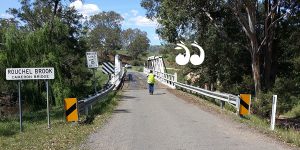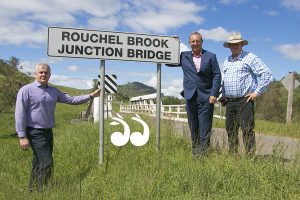Building Bridges At Rouchel
THE Cameron Bridge, built in the 1930’s at Rouchel will be demolished with a new bridge to be built, while the heritage listed Junction Bridge on Upper Rouchel Road will be handed over to Transport NSW for restoration and management.
At the Council meeting in April the naming of bridges was raised, with Cr Kiwa Fisher saying while he would like a bridge or major piece of infrastructure named after Sir Alister McMullin, he was uncomfortable in no longer acknowledging William Cameron when the old bridge was demolished.
Cr Fisher outlined the contribution of Sir McMullin to the region, also noting his initiatives with state and federal libraries, suggesting when the library moves into Campbell’s Corner it may be named in his honour.
A report will be made to Council on naming options for all bridges and major infrastructure.
Cameron Bridge
The Cameron Bridge, a 90 year old timber Dare truss bridge over Rouchel Brook on Rouchel Road has deteriorated and will be demolished to make way for a new concrete bridge upstream, with works to be complete by 2021.

Cameron Bridge over the Rouchel Brook, was built in the 1930s and will be demolished to make way for a new bridge upstream.
The existing bridge was named after William Cameron (1877 – 1931) who was born at Rouchel Brook and was a state member of parliament from 1918 to 1931 for the Upper Hunter and Maitland.
In 2017 it could no longer carry heavy vehicles and a temporary low-level structure was put in place adjacent to the bridge.
The new concrete bridge will be able to carry heavy vehicles and the road will be realigned to remove a sharp bend.
Unfortunately, the old bridge can not be retained as it could present a risk during flooding, to the new bridge downstream.
Junction Bridge
The Junction Bridge is also a Dare truss constructed in the 1930’s on Upper Rouchel Road and will be restored.

Junction Bridge will be handed to Transport for NSW to be maintained as an item of state significance. Pictured: Steve McDonald, general manager of Upper Hunter Shire Council, Michael Johnsen, member for Upper Hunter and Cr Maurice Collison.
The bridge is of state-significance due to crosswire planks and was one of only 44 constructed throughout the state, with only 16 remaining and seven to be preserved.
When built in 1930, it cost £3,274 5s 1p, which was a significant spend, equivalent to a value of $275,562. The bridge’s main span is 70 feet and has two 30 feet composite trusses. The abutments are sheathed with four driven piles and to two driven wing wall piles. The piers are concrete columns and headstocks.
In July, Transport for New South Wales will take over management of the bridge.
 scone.com.au
scone.com.au